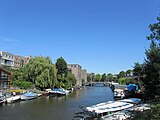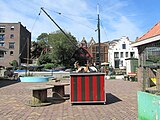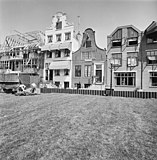 Bickersgracht and Prinseneiland Bickersgracht and Prinseneiland | |
 | |
| Location | Amsterdam |
|---|---|
| Postal code | 1013 |
| Coordinates | 52°23′06″N 4°53′18″E / 52.385085°N 4.888239°E / 52.385085; 4.888239 |
| South end | Eilandsgracht |
| To | Realengracht |
The Bickersgracht (Dutch pronunciation: [ˈbɪkərsˌxrɑxt]) is a canal in the center of Amsterdam at Westelijke Eilanden (Western Islands), but also a street.
Location
The Bickersgracht runs in north-south direction between Bickerseiland and Prinseneiland. The Galgenbrug (bridge no. 315) was constructed between Galgenstraat on Prinseneiland and Kleine Bickersstraat on Bickerseiland. From the street and the bridge, originally a bascule bridge, now a fixed bridge, one had a good view of the gallows of the Volewijck, north of the IJ.
East of the canal and the former location of the shipyards runs a public road. This street, between the houses and the "overtuinen" is paved with cobblestones.
There are seven 17th and 18th century buildings on the Bickersgracht that have been designated as national monuments: six residential houses and warehouse de Faam (Bickersgracht 256), from around 1650. The Dierencapel, a children 's farm, is located at Bickersgracht.
History
The canal is named after Jan Bicker, who bought Bickerseiland in 1631. A number of shipyards, sheds and places to store timber were erected along the Bickersgracht and Westerdok. In the middle of the island a house with a tower was built for the shipping magnate Bicker. This building was demolished around 1700 to make way for more houses.
-
 BickersgrachtBi
BickersgrachtBi
-
 Children's farm
Children's farm
-
 Warehouse "De Faam" (front), Bickersgracht 94, 1959
Warehouse "De Faam" (front), Bickersgracht 94, 1959
-
 Facades on Bickerseiland on the Bickersgracht, 1976
Facades on Bickerseiland on the Bickersgracht, 1976
See also
Notes
Sources
| Canals of Amsterdam | ||
|---|---|---|
| Excludes former canals that have since been filled in | ||
| Amstel sections |  | |
| Inner City | ||
| Lastage | ||
| Grachtengordel | ||
| Jordaan | ||
| Plantage | ||
| Westelijke Eilanden | ||
| Oostelijke Eilanden | ||